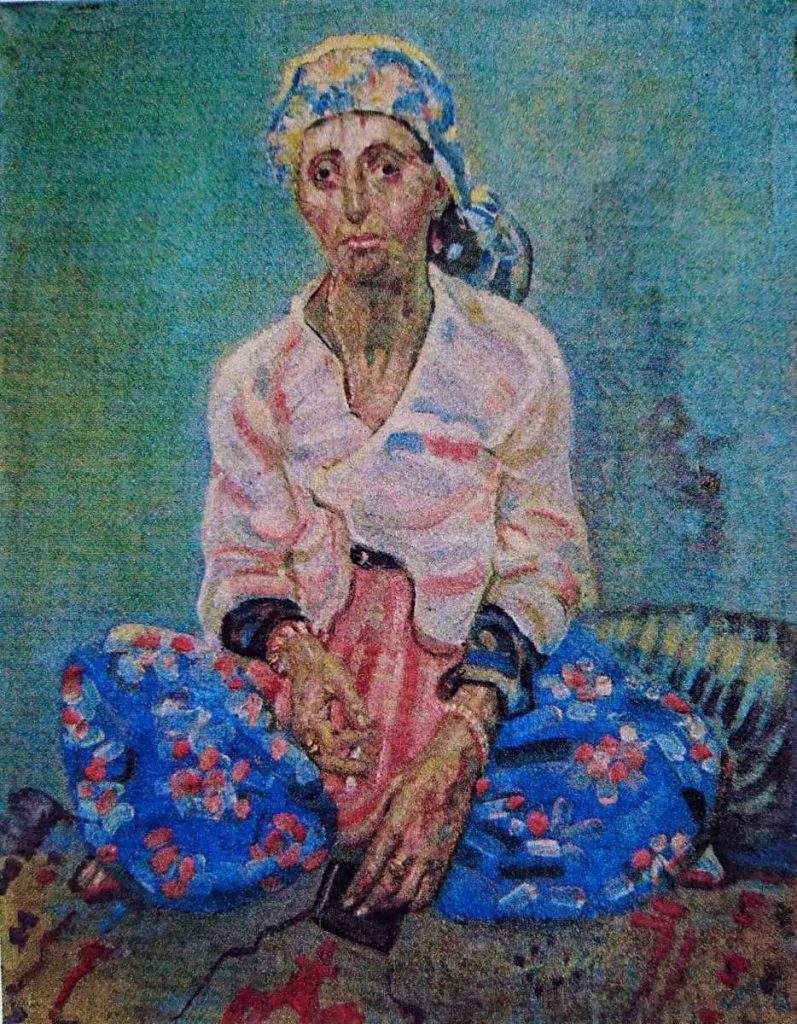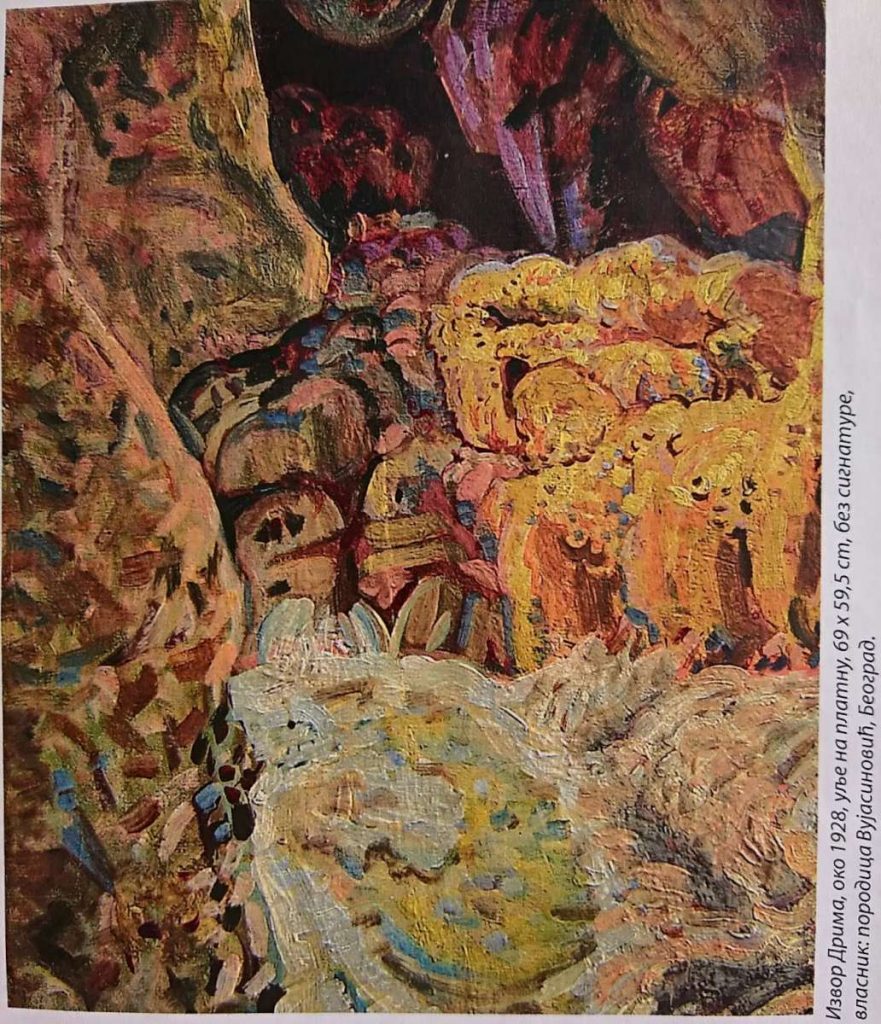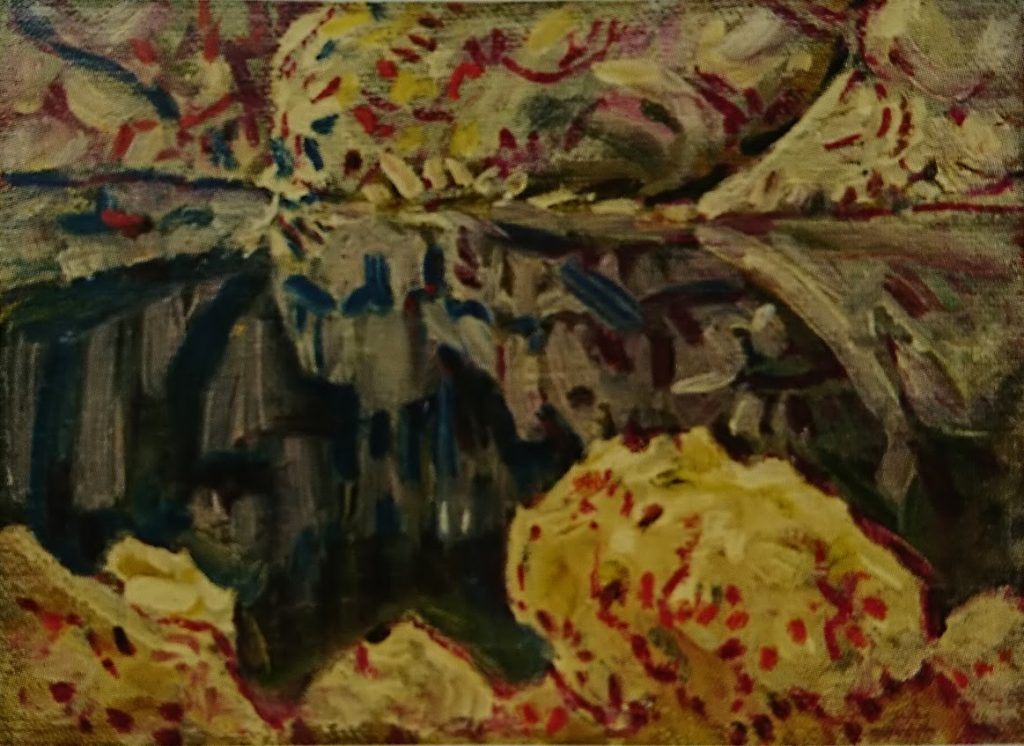“Nicholas Petkovich? It must be Nikola Petković, and I assume a Serbian, but who is he?”
I reached for the “bible” of Yugoslav fine art “Fine Art Encyclopedia of Yugoslavia (Likovna Enciklopedija Jugoslavije), Zagreb 1984” – a massive three chapter book where each chapter has more than 700 pages, where every single Yugoslav painter, no matter how famous, is listed there. But there was no record of “Petković, Nikola”.
“So, it must be an amateur, or they have wrong painter name”, I thought.
The quality of the works was astonishing. As if Vincent van Gogh has painted them himself – coloristic broken impressionism at its finest. I started to put bids, but so does everyone else – the drawings were beautiful, each of them started to fetch 10 times higher price than its original estimation. I watched them go to someone else, one by one, and vanish forever from public. I changed my strategy and decided to focus all my money on bidding on the last three drawings– scenes with Macedonian farmers in traditional folk clothes.
The strategy worked. I won all 3 of them. By the beginning of 2005, I received the package from USA and I started to analyze them. They were even more beautiful than on the photos. Each of them signed with a monogram “N.P.”.
The question remained “Who is Nicholas Petkovich / Nikola Petković / N.P.?”.
I started to search on Google with key words:” Serbian Painter” + “Macedonia” + “1920”. Google started to return information which I begun to document in Excel file. The very first version of this Lexicon! I was surprised how many Serbian painters came in Macedonia in this period 1900-1950 and created remarkable works of art that were likely unknown to Macedonian public (or at least they were unknown to me). The list started to grow: Nikola Arsenović, Hristifor Crnilović, Vasa Eskičević, Ljubomir Ivanović, Paja Jovanović, Nikola Mihalović, Milan Milovanović, Beta Vukanović, Nadežda Petrović…Nadežda Petrović?…N.P.!!!
“Wait a minute! N.P. – can these be drawings of Nadežda Petrović?”, I thought.
Nadežda Petrović (1873-1915) is considered as Serbia’s most important fauvist and impressionist and most important Serbian female painter of the period. She was educated at Munich Fine Art academy and some of the most famous painters in history, for example, Paul Klee and Wassily Kandinsky were impressed by her work. In the period around 1910 she worked in Paris together with famous sculptor Ivan Meštrović. She was very active in her humanitarian work in Kosovo and Macedonia. In 1902 she created the organization Circle of Serbian Sisters with activities in Macedonia. When the Balkan war started in 1912, she became a nurse and travelled with the Serbian Army through Macedonia for which she was awarded with several medals. She volunteered again as a nurse in 1914 when the Great War started and came back to Skopje around 1915. She died from typhus in Valjevo hospital in 1915.
Although the style and the colors were like the work of Nadežda Petrović, I had big doubts, simply because it is not possible so many drawings to come up on the market out of a sudden from such a famous painter. If you have all the luck in the world, you may find one work, but three (and the auction was selling around 12 drawings). I kept my illusion that I MIGHT have Nadežda Petrović at home. In the meantime, I have set search queries on Ebay, Artprice, Invaluable and Findartinfo for “Nicholas Petkovich” and waited for a find.
At the end of 2006, the Ebay search query returned a result.
It was a catalogue of a memorial exhibition in Pittsburgh, PA. from December 10 1955 to January 2 1956 of the reverend and painter Nicholas Petkovich (1893-1952). The book gave information that Petković studied fine art at the famous Academy of Fine Art in Vienna (where Egon Schiele, Gustav Klimt and Oscar Kokoshka studied art) and later he took painting classes at the Carnegie Institute of Technology. He was also a Serbian priest in the Episcopal Church. The foreword was written by the influential Pittsburgh art critics Walter Read Hovey, meaning that Petkovich was known and respected painter in Pittsburgh art circles.
The paintings at the memorial exhibition were from his later phase, the paintings were displaying very spiritual expressionistic religious scenes. But the style and the colors were the same as his “Macedonian” works. Nothing in this book was mentioned about his stay in Macedonia.
I continued my search for a link between Macedonia and this unknown painter. I have put messages on Serbian art blogs with plea for more information about the painter.
In the spring of 2008, I received a reaction.
His name was Miloš Vujasinović. He had a fine art gallery in Philadelphia, but life took him back to Serbia, where he was starting from zero. He had an ambition to open a high-class art gallery where he would discover hidden art gems an bring them for the first time to public. He has found a collection of 40 paintings and drawings of Nikola Petković from a Serbian refugee family from Kordun. All the paintings were motives from Macedonia, Kosovo, and Montenegro. He connected with a well-known Serbian art historian Slanislav Živković and they managed to trace the origin of that collection directly to the widow of Nikola Petković, Mrs. Zora Petković, who came back to Indzija, Vojvodina in 1971 and brought with her more than 200 paintings. Part of those paintings were given as gift to the city of Indzija, part went to private collectors.
The art historian, Mr. Slanislav Živković, was deeply impressed with this find. He described this episode in his book “Life of Paintings” published in 2008 and initiated the municipality of Indzija to organize a memorial exhibition. The Serbian public suddenly discovered Nikola Petković. The Serbian press is full of articles about Petković. The art circles in Serbia started to discover old articles about this painter in newspapers from 1950s. (https://www.eserbia.org/sapeople/art/1005-nikola-petkovic). Suddenly, Nikola Petković became the Serbian Vincent van Gogh – neglected in life, rediscovered in death to a maximal glory. Overnight he was placed in the company of the most important Serbian fauvists of that period.
In the meantime, Miloš Vujasinović, being an art dealer, was trying to sell me three impressive oil on canvas paintings from this collection: “A Fortune Teller” (although not titled by the painter, he was convinced that it is a Macedonian woman), “The spring of river Drim” and “Reflection from the lake water in Ohrid”.
Unfortunately, his asking prices were way above my budget. I am just a simple engineer with family and small children. We did not make a deal. But Mr. Vujasinović gave me all the information about Nikola Petković. The mystery was solved, after 4 years of searching.
Mr. Nikola Petković was born in Indzija, Vojvodina on 18.08.1893, in a wealthy and influential family. In 1911, he studied art at the famous Academy of Applied Arts (“Kunstgewerbeschule”) in Vienna. With the beginning of the Balkan war in 1912, he quit the studies and volunteered in Serbian army in military hospital.
In the period 1912-1916 he was a teacher in Ohrid. He felt in love in Ohrid and Macedonia instantly. He started to paint and draw Ohrid landscapes and Macedonian farmers in traditional folk clothes in typical daily activities. He spent time in cave churches of Ohrid where he painted and prayed. The spiritual power of Ohrid made him deeply spiritual as well.
Suddenly his financial situation worsened, and he immigrated to America in 1916 “with 6 dollars in his pocket”. In Pittsburgh, he was accepted by Serbian Orthodox Church where he became a priest. He continued painting and took evening classes at the Carnegie Institute of Technology, School of Painting and Decoration in Pittsburgh. His work became darker and more expressionistic. He was not known to wide public, but he was noticed and praised by Pittsburgh fine art critics.
He came one last time in Macedonia in the period between 1927-1934, where he returned to his coloristic impressionism where he created perhaps the best works of art in his career.
Nikola Petković, Examples of his paintings from Macedonia 1927-1934
In 1934 he permanently went back to USA, where he died from paralysis in 1952. Apart from the memorial exhibition in 1955, he was forgotten in USA. His wife Zora travelled back to Serbia in 1971 where she brought more than 200 of his painting, but besides small exhibition and article in newspaper, this event went largely unnoticed. Until 2008, when he got discovered and loudly praised by all art critics of Serbia.
It took 4 years to solve the mystery of “the teacher from Ohrid”. The whole experience was not discouraging for me. On the contrary, it motivated me to expand the search to all painters that visited Macedonia and expand the time scope to a 100 years period of 1850-1950. In those 4 years, the “Lexicon” project started to grow and transform from an Excel list into a lexicon with biographies. My private collection with works of art started to grow as well. I learned the lesson that this project will be a marathon rather than a sprint. Nikola Petković was not the only one, for many other painters in this lexicon it took me years to find their link with Macedonia. But this will be told in some other story.


